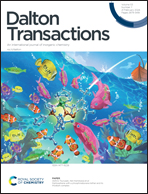New copper(ii) and oxidovanadium(iv) complexes with a vitamin B6 Schiff base: mechanism of action and synergy studies on 2D and 3D human osteosarcoma cell models†
Abstract
We report the synthesis, characterization and anticancer activity of a new Schiff base (H2L) derived from the condensation of pyridoxamine with pyridoxal and its novel copper(II) and oxidovanadium(IV) complexes: [Cu(HL)Cl] (1), [Cu(LH2)(phen)]Cl2 (2), [Cu(LH2)(amphen)]Cl2 (3), [VIVO(HL)Cl] (4), and [VIVO(LH2)(phen)]Cl2 (5), where phen is 1,10-phenanthroline and amphen is its 5-amino derivative. All compounds were characterized by analytical and spectroscopic techniques, namely FTIR, UV-vis and EPR spectroscopy. Their stability in aqueous media was evaluated, revealing that the presence of the phen co-ligand significantly increases the stability. The ternary Cu(II) complexes (2 and 3) impaired cell viability of osteosarcoma cells (MG-63) (IC50 values of 3.6 ± 0.6 and 7 ± 1.9 μM for 2 and 3), while 1 and the VIVO complexes did not show relevant anticancer activity. Complexes 2 and 3 are also more active than cisplatin (CDDP). Synergistic studies between 2 and sorafenib showed significant synergism on MG-63 cells for the following combinations: 2 (2.0 μM) + sorafenib (10.0 μM) and 2 (2.5 μM) + sorafenib (12.5 μM), whilst the combination of 2 and CDDP did not show synergy. Complex 2 interacts with DNA, inducing significant genotoxic effects on MG-63 cells from 1.0 to 2.5 μM and it increases the ROS levels 880% over basal. Moreover, 2 induces apoptosis at 1.0 and 2.0 μM, while its combination with sorafenib induces apoptosis and necrosis. Finally, compound 2 reduces the cell viability of MG-63 spheroids showing an IC50 value 7-fold lower than that of CDDP (8.5 ± 0.4 μM vs. 65 ± 6 μM). The combination of 2 and sorafenib also showed synergism on spheroids, suggesting that the combination of these drugs improves the anticancer effect against bone cancer cells.



 Please wait while we load your content...
Please wait while we load your content...